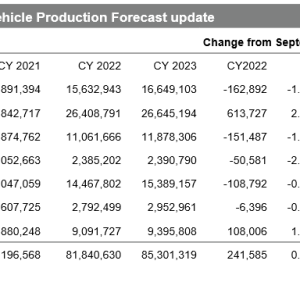
October Forecast: As supply chain challenges ease, demand headwinds could impact global light vehicle production
This short article was released by S&P Global Mobility and not by S&P Global Ratings, which is an individually managed division of S&P Global.
S&P Global Mobility experts have released the current international
light automobile production projection update, with additional reductions
throughout a number of areas offered ongoing supply chain challenges.As ongoing supply chain difficulties continue to slowly
improve, markets are progressively considering the harmful
forces of high inflation, increasing interest rates and the specter of
economic stagnation or outright contraction in essential markets such as
the US and West Europe pressing fragile bottled-up demand, according
to the current standard light lorry production forecast update
from S&P Global Mobility.While the instant near-term outlook is supported by continued
strong performance in Greater China and South Asia through the
balance of 2022, possibly more significant are the down
modifications for North America, Europe and other markets to show
the effects of increased need destruction.In the longer term, car pricing will stay a secret
factor to consider and a prospective headwind to demand, especially as
numerous markets shift to much greater levels of electrification, The October 2022 forecast update reflects near-term upgrades for
Greater China on the strength of need stimulus and South Asia as
the area take advantage of a stabilized supply chain supporting
efforts to clear order stockpiles.” Greater China is rebounding highly since the lockdowns of
Q2 while OEMs in Europe and North America are still constrained by
difficulty in securing component materials,” said Mark
Fulthorpe, executive director, light car production forecasting
at S&P Global Mobility.However, perhaps more crucial are the near-to-intermediate
term down revisions particularly focused on Europe, North
America and Japan and eventually other regions.While semiconductor availability remains an essential
consideration, need destruction is expected to play a more
essential role and speed up in 2023 in a number of key markets,
affecting production through the intermediate term and the
magnitude/need for stock restocking.
Leave a reply